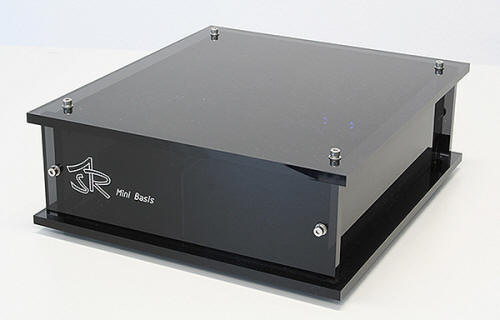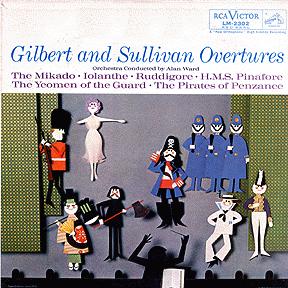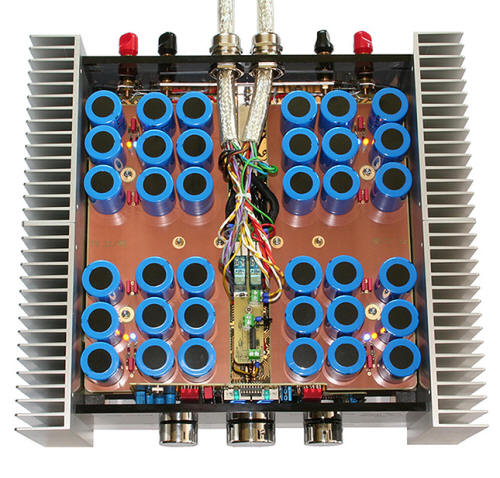
You are reading the older HTML site
Positive Feedback ISSUE
may/june 2008
asr
Mini Basis MKII Phono Preamplifier
as reviewed by Marshall Nack

|
the Small Fry
I never would have imagined I'd be witness to the second coming. In a completely unforeseen twist of fate, those mildewed vinyl LPs in thrift shops with decomposing cardboard jackets have become objects of desire for young people. For proof, read the recurring newspaper articles. Then look at the offerings for budget phono stages and turntables—analog front-ends are the hottest category in the high-end marketplace. (In truth, they may be the only segment with healthy vital signs).
Odder still, this is occurring at a time when retail music outlets are closing left and right as internet downloads have taken over and source quality is plummeting. What does it mean? Will the trend have legs or is it just the latest passing fad?
What is clear is analog front-ends are selling, supported by generally quite favorable press from the audiophile media. The reviews more often than not create the impression that if you spend $800 or $1500 for one of these phono stages you'll get a heaping helping of what the medium is capable of and you'll be relaxing in analog heaven in short order.
Well, it ain't true. While nobody expects sub $2K components to play on the same field as more expensive gear—they are designed to fit into systems of comparably priced components—the problems run deeper. It's not just a matter of scaled down performance.
The budget phono stages I've experienced are chock-a-block with compromises, some severe enough to preclude listening enjoyment. At this price point, you're likely to come up against:
-
Limited dynamic range, like listening to FM radio nowadays—all compressed and equalized.
-
Limited frequency range. The extremes are foreshortened. There's little deep bass or high treble.
-
Loose control and fat images, with soft transients and consequent sluggish pacing.
-
Stage width is OK, but there's no depth layering to speak of.
-
Very often the soundstage is not coherent. Some sounds project forward, while others recede without any rhyme or reason. Images can't be localized, and hence have no shape. The stage perspective does not compute. This is not a minor thing.
-
There are telltale signs of the gear's topology. The solid-state units sound like solid-state, especially in the lack of body. The tube units likewise carry the expected filament traits.
I did find one good thing: many had decent tone. That is, for the most part you can recognize instruments—there are enough cues to give a positive ID.
Understand the context of these gripes is in comparison to a relatively high standard, the Big Boys that were in my Phono Stage Hoedown. These had sticker prices in the $5500 to $8000 price range. Since that time, I've mostly been listening to the Art Audio Vinyl Reference.
Budget phono stages can be problematic in all these ways. This opinion reflects my sampling of three models, admittedly not a lot of exposure at this price point. The door is open that there are exceptions.
The Exception
Count the ASR Mini Basis among them. Hooked up to the VYGER Baltic M turntable with a Shelter Harmony cartridge, you can't fail to note how nicely the Mini manages to sidestep the pitfalls common to this group. (At an MSRP of $1900, I still consider it fits in the category, if at the top end. This brings my sampling up to four.)
Here's the quick impression, applying the same high standards and hitting the points mentioned above.
On a reasonably good LP, like Dvorak's New World Symphony with Zubin Mehta and the LA Philly (London CS 6980), the Mini threw a wide stage without the credibility issues of the budget gear. Instruments were where you expected them to be and in correct relative position to each other. Pacing was excellent: the tune had rhythm and flow. Timbre is convincing: violin tone is commendable. There's no issue of identifying instruments.
The Mini's treble is expertly voiced and does not present any issues. It is completely integrated, without glare or grain, and lacks a mechanical signature. That's another point: the Mini is artifact-free, period. You won't find telltale traces of the units' solid-state topology.
The mid-band is a bit on the dry side, but is otherwise clean, even and unremarkable.
Bass alone may give one pause. There's plenty of it, but it's warm and a bit loose, the kind of bass we often describe as holistic, rather than tight and punchy.
In true ASR fashion, dynamic swells are the Mini's pride. There is a wide range between soft and loud, and low-end volleys are capable of giving you a decent pummeling. Those volleys won't come packaged with breakup. In the area of dynamics the Mini rates very high.
Now let's put on a really fine Shaded Dog LP, Gilbert and Sullivan Overtures (LSC-2302), an old TAS List item.

The better the source going in, the more the Mini impressed me. It rose to the occasion to the extent I started to think maybe I'd been underestimating it. This was darn good! (I just wished I liked this music more, because there's so many great sounding Gilbert and Sullivan LPs.) Location cues are now more specific with no spurious residue littering the area beyond the images' boundary. The images have good shape—boundaries have become crisp. More info is available about color and tonal shadings. Brass instruments avoid harshness but exhibit the necessary bit of bite. The soundstage pushed out to the walls in all dimensions.
The Mini seems to have straddled into a higher class with this excellent LP. I make note again of the outstanding dynamic range. Really, it's wide enough to make me think of that phrase I coined in the course of reviewing the new Kharma CRM 3.2.2 speakers—dynamic openness. This refers to the ability of some components to go the extra mile and reproduce a more complete replica of the signal, to more closely replicate changes in the source. While I can't say the Mini was doing it with small events, it certainly was happening with full-out crescendos. No matter how strong the signal from the groove, the sound did not flatten before the musicians were done with the phrase, before it had reached its dynamic conclusion. The Mini went wherever the source dictated, even when the source was one of those enhanced audiophile reissue LPs. And it resisted break up or distortion.
You may arrive at the same generalization I did: the Mini may be the only solid-state, budget-priced phono stage that doesn't sound like one.
through the Green Eyeshade
Now it's time for some griping. While the Mini's frequency response is even, extension at the top end is just adequate. Of course the principal note value is present, but I felt the harmonic structure up there not as complete as below. This translates into a lack of support and gives instruments a wishy-washy, weak-kneed aspect.
Dimension cues are changeable. Generally speaking, with average LPs stage depth is a bit foreshortened with a suggestion of a rear hall corner and width is a little crimped.
Images are vague and somewhat fat. You get the general placement: first violins are heard over on the left and close up. They don't wander about but they occupy a goodly amount of soundstage area. Solo instruments image almost as broadly. Nor do instruments have individual 3-D depth. However, stereo separation is excellent and the center image is strong.
While the Mini has lots of body, the tonal balance is on the light side. It took some rummaging in my tweak bag to come up with the Rx to move the balance to where I wanted it. A few Vibrapods under the built-in rubber feet came in handy. These had a less potent effect than I expected—maybe due to the floating circuit board inside the Mini? A single Harmonix RFA-57 dot placed near the IEC plug on the chassis also helped. Ultimately, a set of Harmonix TU-66ZX footers did the trick.
Mini Basis
Overall the Mini is voiced towards the musical side. It is more forgiving than incisive. To a certain extent, this helps it mask problem areas. (You know the rule: the higher the resolution, the more the warts show.)
the Big Guy
Good enough. Now, on to the nitty gritty. Chances are, if you're reading this, you are very interested in how the Mini stacks up against ASR's top-of-the-line Basis Exclusive phono stage, the one with the optional battery power supply (MSRP $7900), the one that came out on top in my Phono Stage Hoedown (N.B. The Mk II revision is due to be released in a couple of months).

Basis Exclusive
Compared to the Basis Exclusive, the Mini is soft. You don't get that wonderful feeling of solidity that the Basis Exclusive engenders. While the Mini's dynamic range is impressive, big swings lack force because the leading edge rolls in. The Mini's transients are not as crisp; their approach can be plotted as a sloping curve, rather than the right-angle ideal you see in cable advertisements.
One notices something similar on the tail end of the note—decay is somewhat lazy. Notes dwindle and fade away without integrity. The Mini doesn't have the same control over the signal.
One of the Basis Exclusive's greatest virtues is exceptional resolution, high enough to make you take notice even if you already own one of the top offerings. The Mini rates just passable here. You don't hear into a large mass, you don't hear the component parts of notes as with the Basis Exclusive.
The Basis Exclusive has a deeply saturated, weighty tone and is near SOTA as far as noise suppression. The Mini is much lighter tonally and has nothing like the dead silence of the Basis Exclusive.
I would rate the Mini, as delivered, at maybe 80% of the Basis Exclusive with battery option; with tweaks, that number goes up to 88%.
Wires
Like the ASR Emitter I Exclusive B, the Mini Basis can sound clinical and off-putting when hooked up with unsuitable wires that compound the latent dryness of its midrange. Wire selection can make all the difference. Whether due to some form of impedance matching, electrical compatibility or their plain old warmth and timbral beauty, I found Kubala-Sosna wires have a special synergy with all the ASR products I've sampled to date. I used a K-S power cord plugged into the active TARA Labs IDAT line conditioner or the passive PM/2 conditioner.

Emitter I Exclusive B
Design and Cosmetics
For $1900 you get a slightly smaller than average sized chassis with clean lines and no frills. (Dimensions : 268 W x 300 D x 110 mm H, weight approx. 4 kg.) There are no controls outside the box, not even an On/Off switch. I left it on all the time and periodically took note of the two blue LEDs inside—that told me the power was on. The designer prefers to use black transparent acrylic on most of his products: he feels it sounds better than sheet metal. I like the way it looks on my rack. I mention this because many components at this price point don't—either manufacturers are shaving costs, or they think there's a certain aesthetic to unfinished metal parts screwed together.
Around back there are single-ended Ins and Outs, a Ground Wire post and an IEC jack. Don't bother listening to the Mini for the first 100 hours. Before then, you'll be on a wild goose chase.
Loading is fully adjustable from 47k for MM down to 10 Ohms for low output MC cartridges with many steps in between, as detailed in the comprehensive manual. (BTW, the manual is also more complete than what you'd expect in a sub $2K product.) Gain can be set anywhere between 30 dB for MM to a maximum of 72 for low output MC. Capacitance is also adjustable. To adjust any of these, use an Allen wrench to remove the four screws holding the top cover in place, then don't be surprised to find four banks of DIP switches, two banks for each side, even though it is not a dual-mono design. The row of six DIP switches adjusts Gain; the row of 10 is for Input Loading and Capacitance. Important: make sure the settings for left and right are matching. For the 0.5mV Shelter Harmony cartridge, I set the Mini to about 100 ohms loading and gain at 65 dB.
The first version Mini Basis had an MSRP of $1200. The current Mk II re-design has an MSRP of $1900 and incorporates gold traces on the circuit board and many upgraded parts. The circuit and the layout have been re-thought and significantly re-designed. The board itself is about twice as thick. FYI: an Exclusive version is also available at MSRP $2900. I haven't heard it.
Conclusion
In a strange twist of fate, analog front-ends are driving the low-end of the high-end market. Who'd-a-thunk it, just a couple of years ago? And budget phono stages are garnering glowing reviews, which I find a further strain on credibility, in light of the three that I've sampled.
Nobody expects a sub $2K component to play on the same field as more expensive gear, but the problems go beyond a matter of reduced performance. The kinds of compromises I heard were severe enough to preclude listening enjoyment. I'm harping on this because these units are reviewed as if they're great stuff, and that's simply not true.
The ASR Mini Basis is an exception to this generalization. While it shares many of the groups concerns, none are exhibited to the same debilitating degree. It covers the lay of the land without major issues. My biggest reservations had to do with its light tonal balance and the lack of underlying support, which leaves instruments with a shiftless, insubstantial aspect. A set of Harmonix TU-66ZX footers went far towards remedying both of these.
The Mini can be inserted into topflight systems without causing discomfort or embarrassment. Hooked up to the VYGER Baltic M turntable and a Shelter Harmony cartridge on the business end of the tonearm, I was all set. Everything I needed was there to delve into and enjoy my stash of LPs. In true ASR fashion, dynamic swells are especially the Mini's pride. In this capacity it was outstanding. In other regards the Mini is voiced towards the musical side—it is more forgiving than incisive. Don't expect to get cutting-edge resolution and insight into the source.
I'm not saying the ASR Mini Basis Mk II is the best phono stage ever—it isn't. But judicious tweaking can get you pretty far along towards the Big Boys. I reckon the Mini gives you about 80% of the top-of-the-line Basis Exclusive with battery option (MSRP $7900). Tweaking can push that number up to 88%. The thing to note is it is head and shoulders above the competition at its price point. So far, it's the only solid-state, budget-priced phono stage I've heard that doesn't sound like one. To better it, you'd have to move up to something like the tubed Artemis Labs PL-1 phono stage (MSRP $4000).
ASR Mini Basis Mk II Phono Preamp
Retail: $1900
ASR Audio Systeme
web address:
www.asraudio.de
Distributor Information
Half Note Audio
DeKalb, IL 60115
web address:
www.halfnoteaudio.com
